Attached files
| file | filename |
|---|---|
| EX-99.1 - EXHIBIT 99.1 - BrightSphere Investment Group plc | omam-2017331xpressreleasee.htm |
| 8-K - 8-K - BrightSphere Investment Group plc | omam-q1x20178xkearningsrel.htm |
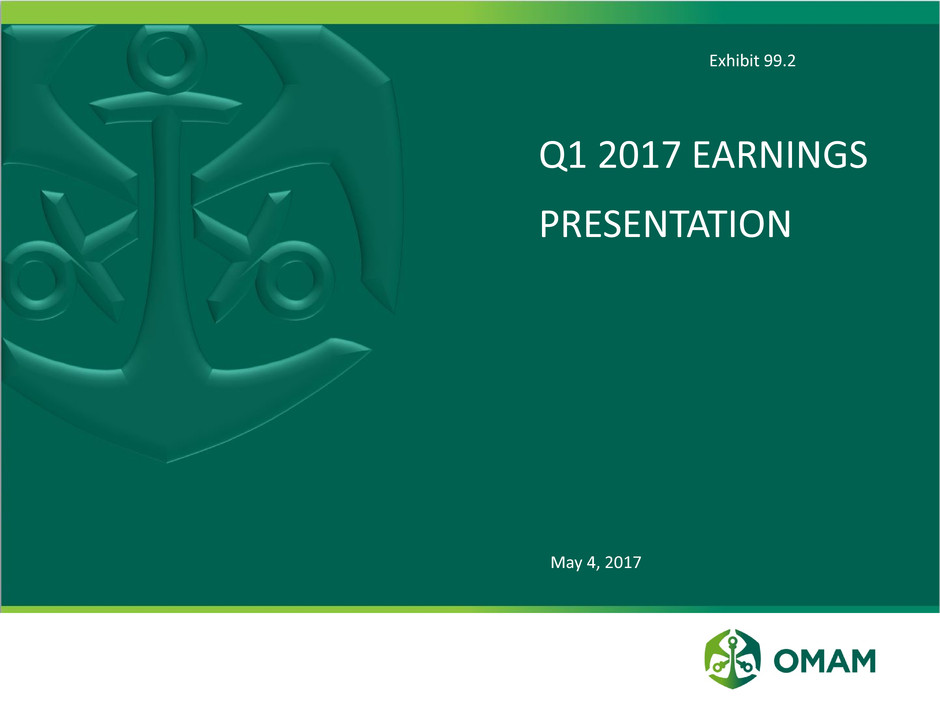
1
Q1 2017 EARNINGS
PRESENTATION
May 4, 2017
Exhibit 99.2

2
Disclaimer
Forward Looking Statements
This presentation may contain forward looking statements for the purposes of the safe harbor
provision under the Private Securities Litigation Reform Act of 1995. Forward-looking statements
are identified by words such as “expect,” “anticipate,” “may,” “intends,” “believes,” “estimate,”
“project,” and other similar expressions.
Such statements involve a number of risks, uncertainties and other factors that could cause actual
results to differ materially from these forward looking statements. These factors include, but are
not limited to, the factors described in OMAM’s filings made with the Securities and Exchange
Commission, including our most recent Annual Report on Form 10-K, filed with the SEC on
February 22, 2017, under the heading “Risk Factors.”
Any forward-looking statements in this presentation are based on assumptions as of today and we
undertake no obligation to update these statements as a result of new information or future
events. We urge you not to place undue reliance on any forward-looking statements.
Non-GAAP Financial Measures
This presentation contains non-GAAP financial measures. Reconciliations of GAAP to non-GAAP
measures are included in the appendix to this presentation.
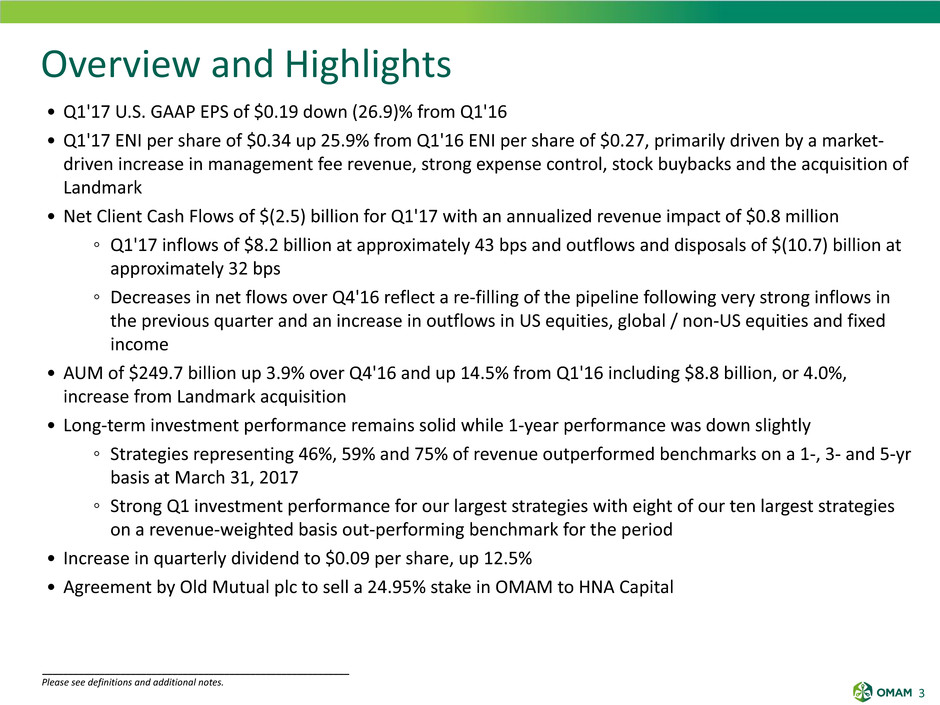
3
Overview and Highlights
• Q1'17 U.S. GAAP EPS of $0.19 down (26.9)% from Q1'16
• Q1'17 ENI per share of $0.34 up 25.9% from Q1'16 ENI per share of $0.27, primarily driven by a market-
driven increase in management fee revenue, strong expense control, stock buybacks and the acquisition of
Landmark
• Net Client Cash Flows of $(2.5) billion for Q1'17 with an annualized revenue impact of $0.8 million
◦ Q1'17 inflows of $8.2 billion at approximately 43 bps and outflows and disposals of $(10.7) billion at
approximately 32 bps
◦ Decreases in net flows over Q4'16 reflect a re-filling of the pipeline following very strong inflows in
the previous quarter and an increase in outflows in US equities, global / non-US equities and fixed
income
• AUM of $249.7 billion up 3.9% over Q4'16 and up 14.5% from Q1'16 including $8.8 billion, or 4.0%,
increase from Landmark acquisition
• Long-term investment performance remains solid while 1-year performance was down slightly
◦ Strategies representing 46%, 59% and 75% of revenue outperformed benchmarks on a 1-, 3- and 5-yr
basis at March 31, 2017
◦ Strong Q1 investment performance for our largest strategies with eight of our ten largest strategies
on a revenue-weighted basis out-performing benchmark for the period
• Increase in quarterly dividend to $0.09 per share, up 12.5%
• Agreement by Old Mutual plc to sell a 24.95% stake in OMAM to HNA Capital
___________________________________________________________
Please see definitions and additional notes.
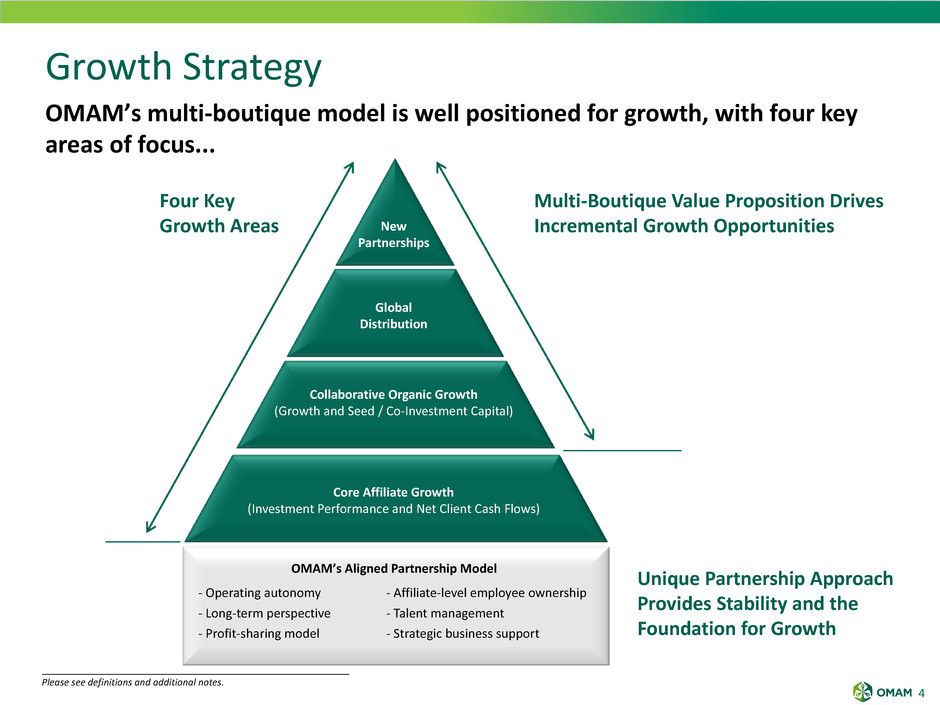
4
Growth Strategy
OMAM’s multi-boutique model is well positioned for growth, with four key
areas of focus...
Multi-Boutique Value Proposition Drives
Incremental Growth Opportunities
Four Key
Growth Areas New
Partnerships
Global
Distribution
Collaborative Organic Growth
(Growth and Seed / Co-Investment Capital)
Core Affiliate Growth
(Investment Performance and Net Client Cash Flows)
OMAM’s Aligned Partnership Model
- Operating autonomy - Affiliate-level employee ownership
- Long-term perspective - Talent management
- Profit-sharing model - Strategic business support
Unique Partnership Approach
Provides Stability and the
Foundation for Growth
___________________________________________________________
Please see definitions and additional notes.
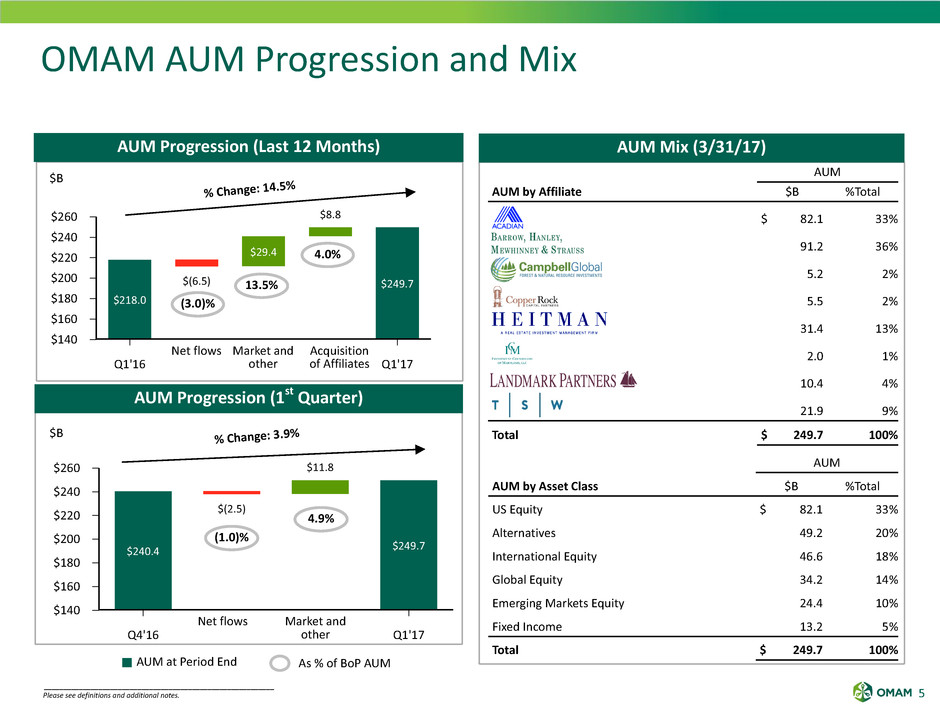
5
AUM
AUM by Affiliate $B %Total
$ 82.1 33%
91.2 36%
5.2 2%
5.5 2%
31.4 13%
2.0 1%
10.4 4%
21.9 9%
Total $ 249.7 100%
$260
$240
$220
$200
$180
$160
$140
Q1'16 Q1'17
$218.0
$(6.5)
$29.4
$8.8
$249.7
OMAM AUM Progression and Mix
AUM Progression (Last 12 Months) AUM Mix (3/31/17)
AUM
AUM by Asset Class $B %Total
US Equity $ 82.1 33%
Alternatives 49.2 20%
International Equity 46.6 18%
Global Equity 34.2 14%
Emerging Markets Equity 24.4 10%
Fixed Income 13.2 5%
Total $ 249.7 100%
AUM Progression (1st Quarter)
$260
$240
$220
$200
$180
$160
$140
Q4'16 Q1'17
$240.4
$(2.5)
$11.8
$249.7
AUM at Period End As % of BoP AUM
Net flows Market and
other
Acquisition
of Affiliates
% Change: 14.5%
% Change: 3.9%
4.9%
(1.0)%
(3.0)%
13.5%
___________________________________________________________
Please see definitions and additional notes.
$B
$B
4.0%
Net flows Market and
other

6
Derived
Average
Weighted
NCCF ($b)(2)
Net Client Cash Flows and Revenue Impact
AUM Net Client Cash Flows (“NCCF”) Revenue Impact of NCCF(1)
$24
$20
$16
$12
$8
$4
$0
-$4
-$8
$(3.0)
$18.4 $19.1
$20.0
$11.3
$13.5
$0.7
$(6.6)
$7.3
$(3.4)
$(7.5)
$14.6
$0.8
Q1 Q2 Q3 Q4 Q1 Q2 Q3 Q4 Q1 Q2 Q3 Q4 Q1
40 43 46 44 47 46 46 45 38 46 42 44 43
38 36 38 38 30 31 32 37 40 32 38 35 32
2014 2015 2016 2017
$54.5 $18.9 $11.0 $0.8
Bps inflows
Bps outflows
___________________________________________________________
(1) Annualized revenue impact of net flows represents the difference between annualized management fees expected to be earned on new accounts and net assets contributed to existing accounts, less the annualized management fees lost on
terminated accounts or net assets withdrawn from existing accounts, including equity-accounted Affiliates. Annualized revenue is calculated by multiplying the annual gross fee rate for the relevant account by the net assets gained in the account in
the event of a positive flow or the net assets lost in the account in the event of an outflow.
(2) Derived Average Weighted NCCF reflects the implied NCCF if annualized revenue impact of net flows represents asset flows at the weighted fee rate for OMAM overall (i.e. 37.7 bps in Q1'17). For example, NCCF annualized revenue impact of $0.8
million divided by average weighted fee rate of OMAM’s overall AUM of 37.7 bps equals the derived average weighted NCCF of $0.2 billion.
$4
$2
$0
-$2
-$4
$(1.0)
$3.6
$3.1
$3.8
$(0.2)
$0.8
$(2.5)
$(3.2)
$2.4
$(2.9)
$(2.6)
$1.5
$(2.5)
Q1 Q2 Q3 Q4 Q1 Q2 Q3 Q4 Q1 Q2 Q3 Q4 Q1
$ (0.9) $5.5 $5.8 $6.1 $3.3 $3.9 $0.2 $(1.9) $2.1 $(1.0) $(2.1) $4.0 $0.2
2014 2015 2016 2017
$9.5 $(5.1) $(1.6) $(2.5)
$B $M
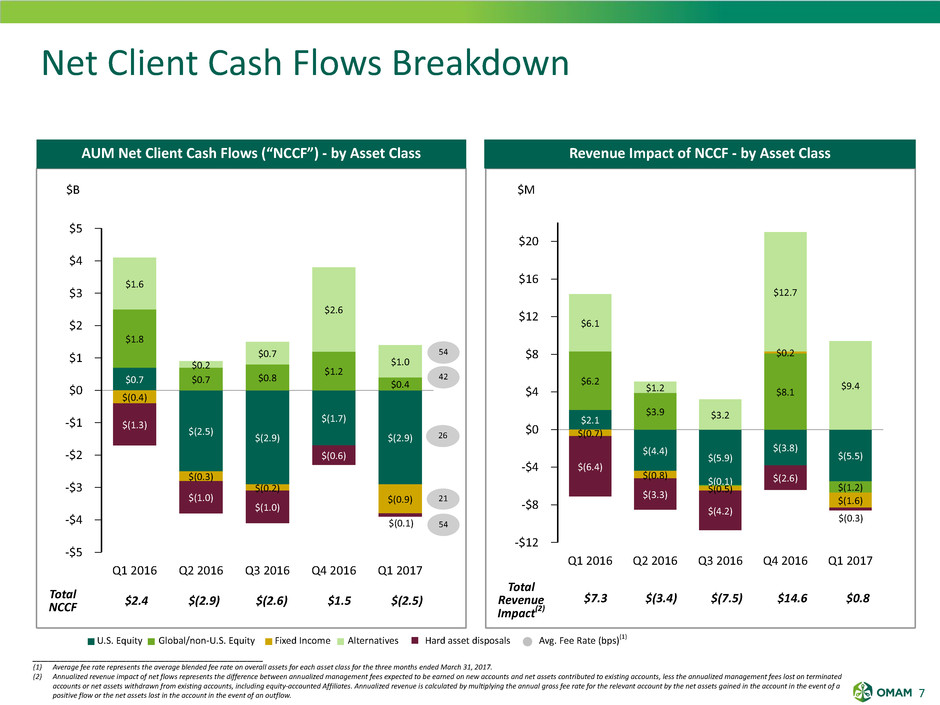
7
Hard asset disposals
$5
$4
$3
$2
$1
$0
-$1
-$2
-$3
-$4
-$5
Q1 2016 Q2 2016 Q3 2016 Q4 2016 Q1 2017
$0.7
$(2.5) $(2.9)
$(1.7)
$(2.9)
$1.8
$0.7 $0.8
$1.2
$0.4
$(0.4)
$(0.3)
$(0.2)
$(0.9)
$(1.3)
$(1.0)
$(1.0)
$(0.6)
$1.6
$0.2
$0.7
$2.6
$1.0
$20
$16
$12
$8
$4
$0
-$4
-$8
-$12
Q1 2016 Q2 2016 Q3 2016 Q4 2016 Q1 2017
$2.1
$(4.4)
$(5.9)
$(3.8)
$(5.5)
$6.2
$3.9
$(0.1)
$8.1
$(1.2)
$(0.7)
$(0.8)
$(0.5)
$0.2
$(1.6)
$(6.4)
$(3.3)
$(4.2)
$(2.6)
$6.1
$1.2
$3.2
$12.7
$9.4
Net Client Cash Flows Breakdown
AUM Net Client Cash Flows (“NCCF”) - by Asset Class Revenue Impact of NCCF - by Asset Class
Total
Revenue
Impact(2)
$7.3 $(3.4) $(7.5) $14.6 $0.8
___________________________________________________________
(1) Average fee rate represents the average blended fee rate on overall assets for each asset class for the three months ended March 31, 2017.
(2) Annualized revenue impact of net flows represents the difference between annualized management fees expected to be earned on new accounts and net assets contributed to existing accounts, less the annualized management fees lost on terminated
accounts or net assets withdrawn from existing accounts, including equity-accounted Affiliates. Annualized revenue is calculated by multiplying the annual gross fee rate for the relevant account by the net assets gained in the account in the event of a
positive flow or the net assets lost in the account in the event of an outflow.
U.S. Equity Global/non-U.S. Equity Fixed Income Alternatives Avg. Fee Rate (bps)(1)
Total
NCCF $2.4 $(2.9) $(2.6) $1.5 $(2.5)
21
26
42
54
$M$B
54 $(0.1) $(0.3)

8
Competitive Long-term Investment Performance
Products representing ≥ 59% of revenue outperforming on a 3- and 5-year basis
Commentary
• OMAM uses revenue-weighted performance as its primary investment metric
◦ Ties investment performance to business performance
◦ Reflects percent of management fee revenue in products outperforming their benchmarks (1)
• OMAM also uses equal-weighted performance as it considers earlier stage products that may grow to have significant impact
• Asset-weighted performance is broadly used across the industry
___________________________________________________________
1. Excludes revenue in products which are not benchmarked; includes management fee revenue from equity-accounted Affiliates in the analysis.
2. Data as of March 31, 2017.
3. Revenue-Weighted: Calculates each strategy’s percentage weight by taking its estimated composite revenue over total composite revenues in each period, then sums the total percentage of strategies outperforming.
4. Equal-Weighted (>$100m): Each strategy over $100m has the same weight, then sums the total percentage of strategies outperforming.
5. Asset-Weighted: Calculates each strategy’s percentage weight by taking its composite AUM over total composite AUM in each period, then sums the total percentage of strategies outperforming.
6. Barrow Hanley’s Windsor II Large Cap Value account AUM and return are separated from Barrow Hanley’s Large Cap Value composite in revenue-weighted, equal-weighted and asset-weighted outperformance percentage calculations.
100%
80%
60%
40%
20%
0%
1-Year 3-Year 5-Year
37%
49%
63%
100%
80%
60%
40%
20%
0%
1-Year 3-Year 5-Year
49%
66%
78%
100%
80%
60%
40%
20%
0%
1-Year 3-Year 5-Year
46%
59%
75%
Revenue-Weighted (2)(3)(6) Equal-Weighted (>$100m) (2)(4)(6) Asset-Weighted (2)(5)(6)
% outperformance vs. benchmark % outperformance vs. benchmark % outperformance vs. benchmark
Q4’16 49% 55% 73%
Q1’16 46% 68% 77%
Q4’16 53% 65% 76%
Q1’16 63% 82% 84%
Q4’16 42% 45% 61%
Q1’16 53% 66% 65%
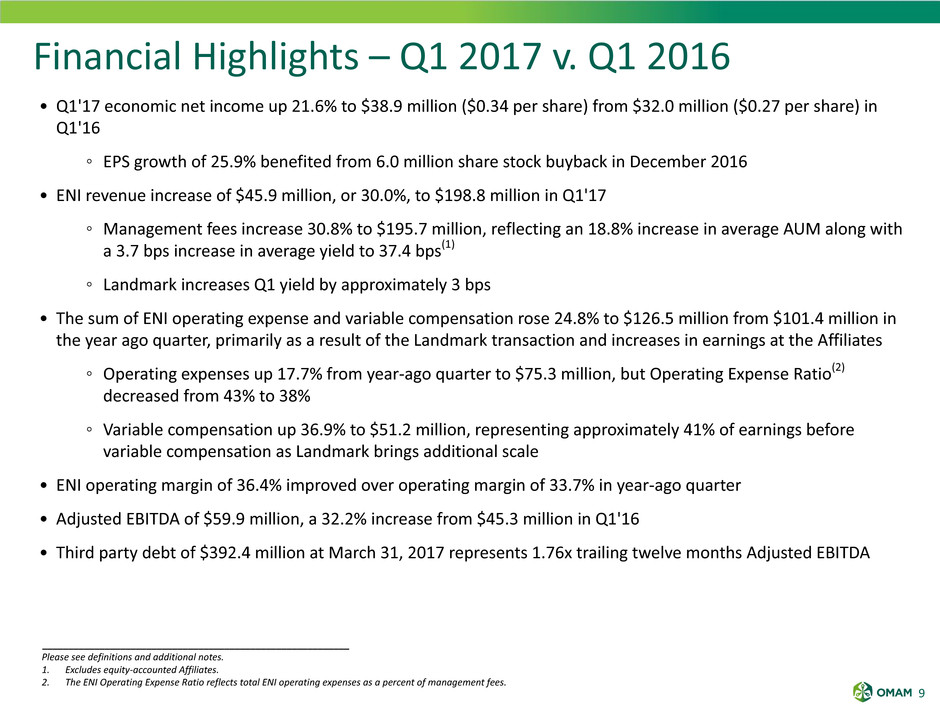
9
Financial Highlights – Q1 2017 v. Q1 2016
• Q1'17 economic net income up 21.6% to $38.9 million ($0.34 per share) from $32.0 million ($0.27 per share) in
Q1'16
◦ EPS growth of 25.9% benefited from 6.0 million share stock buyback in December 2016
• ENI revenue increase of $45.9 million, or 30.0%, to $198.8 million in Q1'17
◦ Management fees increase 30.8% to $195.7 million, reflecting an 18.8% increase in average AUM along with
a 3.7 bps increase in average yield to 37.4 bps(1)
◦ Landmark increases Q1 yield by approximately 3 bps
• The sum of ENI operating expense and variable compensation rose 24.8% to $126.5 million from $101.4 million in
the year ago quarter, primarily as a result of the Landmark transaction and increases in earnings at the Affiliates
◦ Operating expenses up 17.7% from year-ago quarter to $75.3 million, but Operating Expense Ratio(2)
decreased from 43% to 38%
◦ Variable compensation up 36.9% to $51.2 million, representing approximately 41% of earnings before
variable compensation as Landmark brings additional scale
• ENI operating margin of 36.4% improved over operating margin of 33.7% in year-ago quarter
• Adjusted EBITDA of $59.9 million, a 32.2% increase from $45.3 million in Q1'16
• Third party debt of $392.4 million at March 31, 2017 represents 1.76x trailing twelve months Adjusted EBITDA
___________________________________________________________
Please see definitions and additional notes.
1. Excludes equity-accounted Affiliates.
2. The ENI Operating Expense Ratio reflects total ENI operating expenses as a percent of management fees.

10
Pre-tax ENI
$250
$225
$200
$175
$150
Q1'16 Q2'16 Q3'16 Q4'16 Q1'17
$211
$219
$228
$235
$246
$70
$60
$50
$40
$30
$20
Q1'16 Q2'16 Q3'16 Q4'16 Q1'17
$43 $48
$50 $48 $52
$0.40
$0.30
$0.20
$0.10
$0.00
Q1'16 Q2'16 Q3'16 Q4'16 Q1'17
$0.27 $0.30
$0.32 $0.32 $0.34
ENI Per Share(4)
ENI Revenue(1)
$210
$180
$150
$120
$90
$60
$30
$0
-$30
Q1'16 Q2'16 Q3'16 Q4'16 Q1'17
$153 $161 $177
$185 $199
$199
___________________________________________________________
Please see definitions and additional notes.
1. ENI Revenue consists of management fees, performance fees, and other income, which primarily consists of earnings of our equity-accounted Affiliates.
2. Includes fees for equity-accounted Affiliates.
3. ENI Operating Margin represents ENI operating margin before Affiliate key employee distributions. This is a non-GAAP efficiency measure, calculated based on ENI operating earnings divided by ENI Revenue.
4. ENI per share is calculated as Economic Net Income divided by weighted average diluted shares outstanding.
Improving Markets and Fee Mix Benefit Q1’17
Results
$200
$150
$100
$50
Q2’15 Q3’15 Q4’15 Q1’16 Q2’16
$167 $163 $161 $153
$200
Average AUM
Fee Rate (Basis Points)(2) ENI Operating Margin(3)
40.0
35.0
30.0
25.0
20.0
Q1'16 Q2'16 Q3'16 Q4'16 Q1'17
34.7 35.0 35.7
36.1
37.7
$0.33
$0.27
$0.30
% Change Q1’16 to Q1’17: 16.7% % Change Q1’16 to Q1’17: 30.0%
% Change Q1’16 to Q1’17: 25.9%
$190
$153
Performance
Fees
$160
$0.32
Performance
Fees
$199
% Change ex. perf. fees: 29.9%
$51
$43
$48
$52
Performance
Fees% Change Q1’16 to Q1’17: 22.1%
45%
38%
31%
24%
17%
10%
Q1'16 Q2'16 Q3'16 Q4'16 Q1'17
33.7% 36.2% 37.0% 34.9% 36.3%
36.4%
33.7%
35.8% 36.5%
Performance
Fees
$0.34
% Change ex. perf. fees: 21.2%
$m$b $m
$176
$49
35.8%
$(1)
4.5%
7.2%
9.2%
6.3%
$(1)
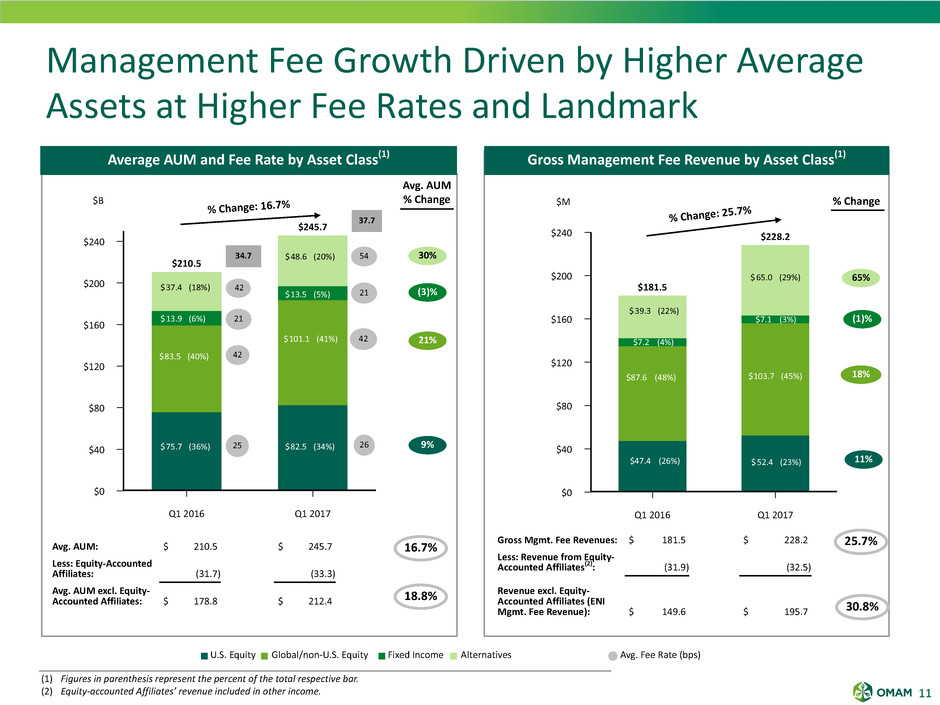
11
Management Fee Growth Driven by Higher Average
Assets at Higher Fee Rates and Landmark
______________________________________________________________________________________________________________
(1) Figures in parenthesis represent the percent of the total respective bar.
(2) Equity-accounted Affiliates’ revenue included in other income.
$240
$200
$160
$120
$80
$40
$0
Q1 2016 Q1 2017
$210.5
$245.7
Gross Management Fee Revenue by Asset Class(1)Average AUM and Fee Rate by Asset Class(1)
U.S. Equity Global/non-U.S. Equity Fixed Income Alternatives Avg. Fee Rate (bps)
$B
Avg. AUM
% Change
30%
(3)%
21%
9% 25
% Change: 16.7%
42
21
42
26
42
21
54
Avg. AUM: $ 210.5 $ 245.7
Less: Equity-Accounted
Affiliates: (31.7) (33.3)
Avg. AUM excl. Equity-
Accounted Affiliates: $ 178.8 $ 212.4
$240
$200
$160
$120
$80
$40
$0
Q1 2016 Q1 2017
$181.5
$228.2
$M % Change
65%
(1)%
18%
11%
% Change: 25.7%
Gross Mgmt. Fee Revenues: $ 181.5 $ 228.2
Less: Revenue from Equity-
Accounted Affiliates(2): (31.9) (32.5)
Revenue excl. Equity-
Accounted Affiliates (ENI
Mgmt. Fee Revenue): $ 149.6 $ 195.7
$75.7 (36%)
$83.5 (40%)
$13.9 (6%)
$37.4 (18%)
$48.6 (20%)
$13.5 (5%)
$101.1 (41%)
$82.5 (34%)
$47.4 (26%)
$87.6 (48%)
$39.3 (22%)
$7.2 (4%)
$ 52.4 (23%)
$103.7 (45%)
$ 65.0 (29%)
$7.1 (3%)
34.7
37.7
16.7%
18.8%
25.7%
30.8%
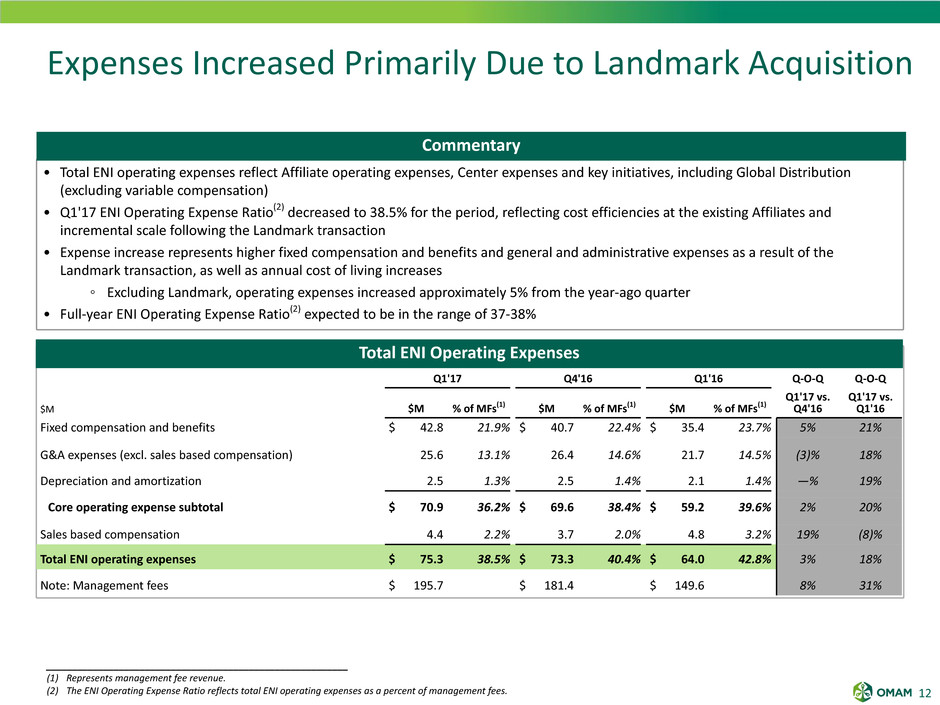
12
Total ENI Operating Expenses
Q1'17 Q4'16 Q1'16 Q-O-Q Q-O-Q
$M $M % of MFs(1) $M % of MFs(1) $M % of MFs(1)
Q1'17 vs.
Q4'16
Q1'17 vs.
Q1'16
Fixed compensation and benefits $ 42.8 21.9% $ 40.7 22.4% $ 35.4 23.7% 5% 21%
G&A expenses (excl. sales based compensation) 25.6 13.1% 26.4 14.6% 21.7 14.5% (3)% 18%
Depreciation and amortization 2.5 1.3% 2.5 1.4% 2.1 1.4% —% 19%
Core operating expense subtotal $ 70.9 36.2% $ 69.6 38.4% $ 59.2 39.6% 2% 20%
Sales based compensation 4.4 2.2% 3.7 2.0% 4.8 3.2% 19% (8)%
Total ENI operating expenses $ 75.3 38.5% $ 73.3 40.4% $ 64.0 42.8% 3% 18%
Note: Management fees $ 195.7 $ 181.4 $ 149.6 8% 31%
• Total ENI operating expenses reflect Affiliate operating expenses, Center expenses and key initiatives, including Global Distribution
(excluding variable compensation)
• Q1'17 ENI Operating Expense Ratio(2) decreased to 38.5% for the period, reflecting cost efficiencies at the existing Affiliates and
incremental scale following the Landmark transaction
• Expense increase represents higher fixed compensation and benefits and general and administrative expenses as a result of the
Landmark transaction, as well as annual cost of living increases
◦ Excluding Landmark, operating expenses increased approximately 5% from the year-ago quarter
• Full-year ENI Operating Expense Ratio(2) expected to be in the range of 37-38%
__________________________________________________________
(1) Represents management fee revenue.
(2) The ENI Operating Expense Ratio reflects total ENI operating expenses as a percent of management fees.
Expenses Increased Primarily Due to Landmark Acquisition
Commentary
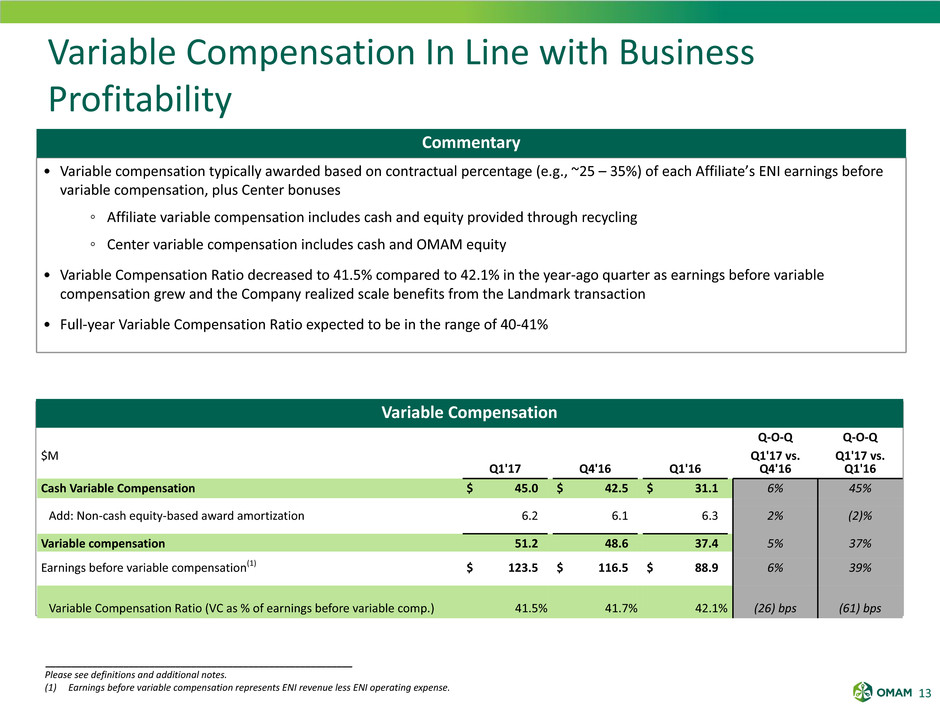
13
• Variable compensation typically awarded based on contractual percentage (e.g., ~25 – 35%) of each Affiliate’s ENI earnings before
variable compensation, plus Center bonuses
◦ Affiliate variable compensation includes cash and equity provided through recycling
◦ Center variable compensation includes cash and OMAM equity
• Variable Compensation Ratio decreased to 41.5% compared to 42.1% in the year-ago quarter as earnings before variable
compensation grew and the Company realized scale benefits from the Landmark transaction
• Full-year Variable Compensation Ratio expected to be in the range of 40-41%
___________________________________________________________
Please see definitions and additional notes.
(1) Earnings before variable compensation represents ENI revenue less ENI operating expense.
Variable Compensation In Line with Business
Profitability
Commentary
Q-O-Q Q-O-Q
$M
Q1'17 Q4'16 Q1'16
Q1'17 vs.
Q4'16
Q1'17 vs.
Q1'16
Cash Variable Compensation $ 45.0 $ 42.5 $ 31.1 6% 45%
Add: Non-cash equity-based award amortization 6.2 6.1 6.3 2% (2)%
Variable compensation 51.2 48.6 37.4 5% 37%
Earnings before variable compensation(1) $ 123.5 $ 116.5 $ 88.9 6% 39%
Variable Compensation Ratio (VC as % of earnings before variable comp.) 41.5% 41.7% 42.1% (26) bps (61) bps
Variable Compensation
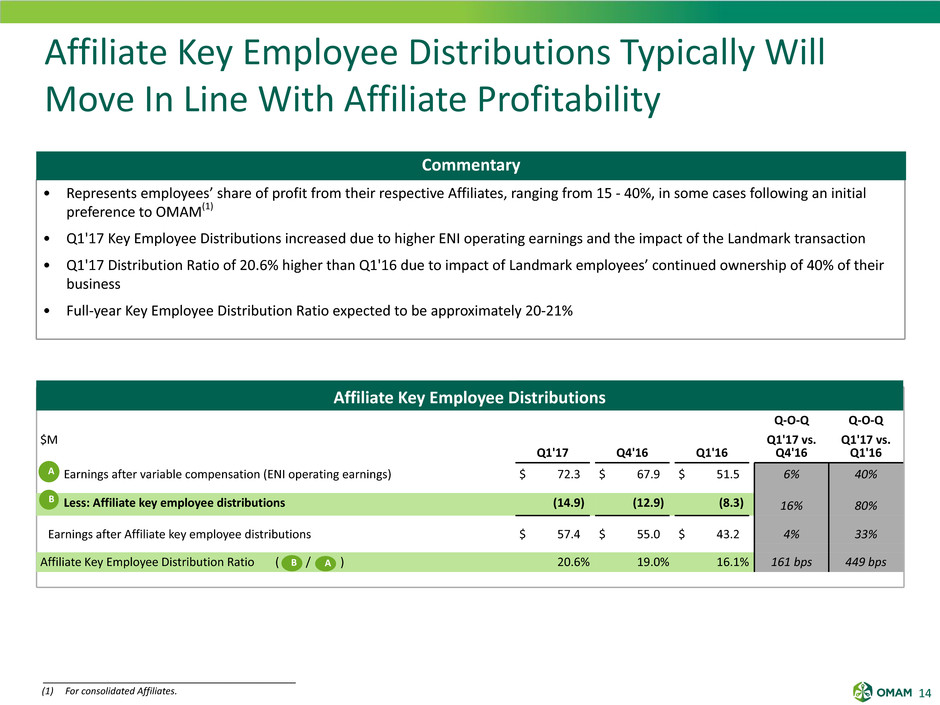
14
Affiliate Key Employee Distributions
Q-O-Q Q-O-Q
$M
Q1'17 Q4'16 Q1'16
Q1'17 vs.
Q4'16
Q1'17 vs.
Q1'16
Earnings after variable compensation (ENI operating earnings) $ 72.3 $ 67.9 $ 51.5 6% 40%
Less: Affiliate key employee distributions (14.9) (12.9) (8.3) 16% 80%
Earnings after Affiliate key employee distributions $ 57.4 $ 55.0 $ 43.2 4% 33%
Affiliate Key Employee Distribution Ratio ( / ) 20.6% 19.0% 16.1% 161 bps 449 bps
• Represents employees’ share of profit from their respective Affiliates, ranging from 15 - 40%, in some cases following an initial
preference to OMAM(1)
• Q1'17 Key Employee Distributions increased due to higher ENI operating earnings and the impact of the Landmark transaction
• Q1'17 Distribution Ratio of 20.6% higher than Q1'16 due to impact of Landmark employees’ continued ownership of 40% of their
business
• Full-year Key Employee Distribution Ratio expected to be approximately 20-21%
__________________________________________________________
(1) For consolidated Affiliates.
Affiliate Key Employee Distributions Typically Will
Move In Line With Affiliate Profitability
Commentary
A
B
B A
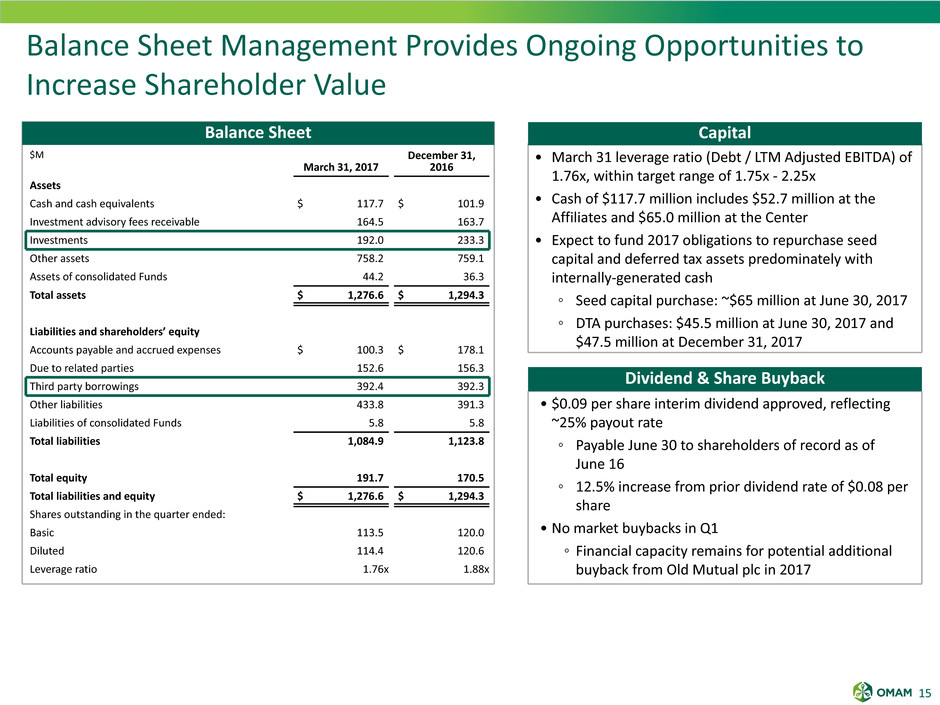
15
$M
March 31, 2017
December 31,
2016
Assets
Cash and cash equivalents $ 117.7 $ 101.9
Investment advisory fees receivable 164.5 163.7
Investments 192.0 233.3
Other assets 758.2 759.1
Assets of consolidated Funds 44.2 36.3
Total assets $ 1,276.6 $ 1,294.3
Liabilities and shareholders’ equity
Accounts payable and accrued expenses $ 100.3 $ 178.1
Due to related parties 152.6 156.3
Third party borrowings 392.4 392.3
Other liabilities 433.8 391.3
Liabilities of consolidated Funds 5.8 5.8
Total liabilities 1,084.9 1,123.8
Total equity 191.7 170.5
Total liabilities and equity $ 1,276.6 $ 1,294.3
Shares outstanding in the quarter ended:
Basic 113.5 120.0
Diluted 114.4 120.6
Leverage ratio 1.76x 1.88x
Balance Sheet
Balance Sheet Management Provides Ongoing Opportunities to
Increase Shareholder Value
• $0.09 per share interim dividend approved, reflecting
~25% payout rate
◦ Payable June 30 to shareholders of record as of
June 16
◦ 12.5% increase from prior dividend rate of $0.08 per
share
• No market buybacks in Q1
◦ Financial capacity remains for potential additional
buyback from Old Mutual plc in 2017
• March 31 leverage ratio (Debt / LTM Adjusted EBITDA) of
1.76x, within target range of 1.75x - 2.25x
• Cash of $117.7 million includes $52.7 million at the
Affiliates and $65.0 million at the Center
• Expect to fund 2017 obligations to repurchase seed
capital and deferred tax assets predominately with
internally-generated cash
◦ Seed capital purchase: ~$65 million at June 30, 2017
◦ DTA purchases: $45.5 million at June 30, 2017 and
$47.5 million at December 31, 2017
Capital
Dividend & Share Buyback
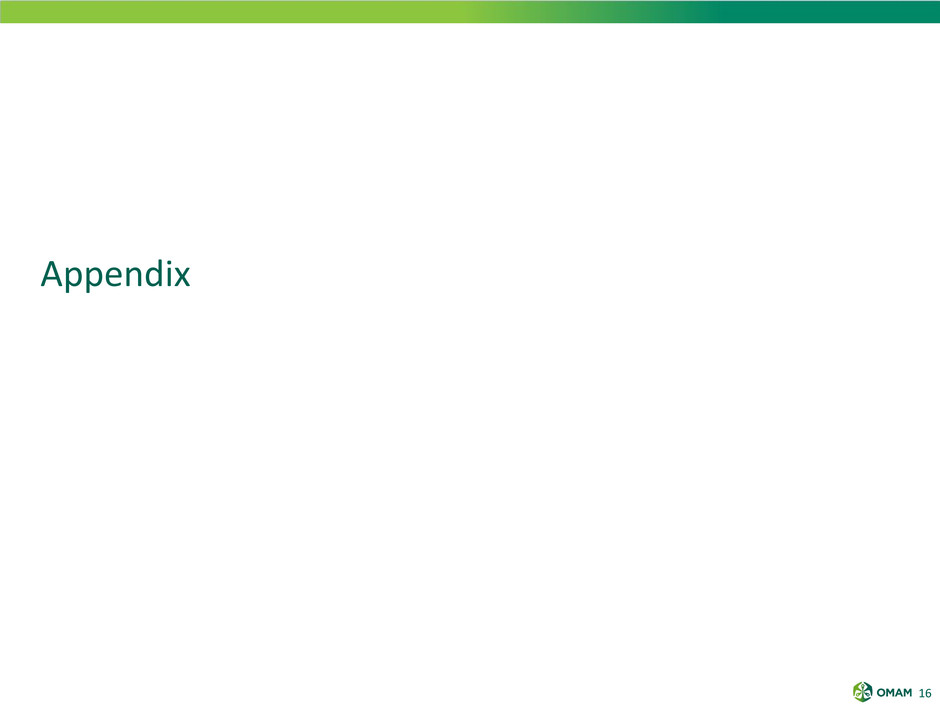
16
Appendix
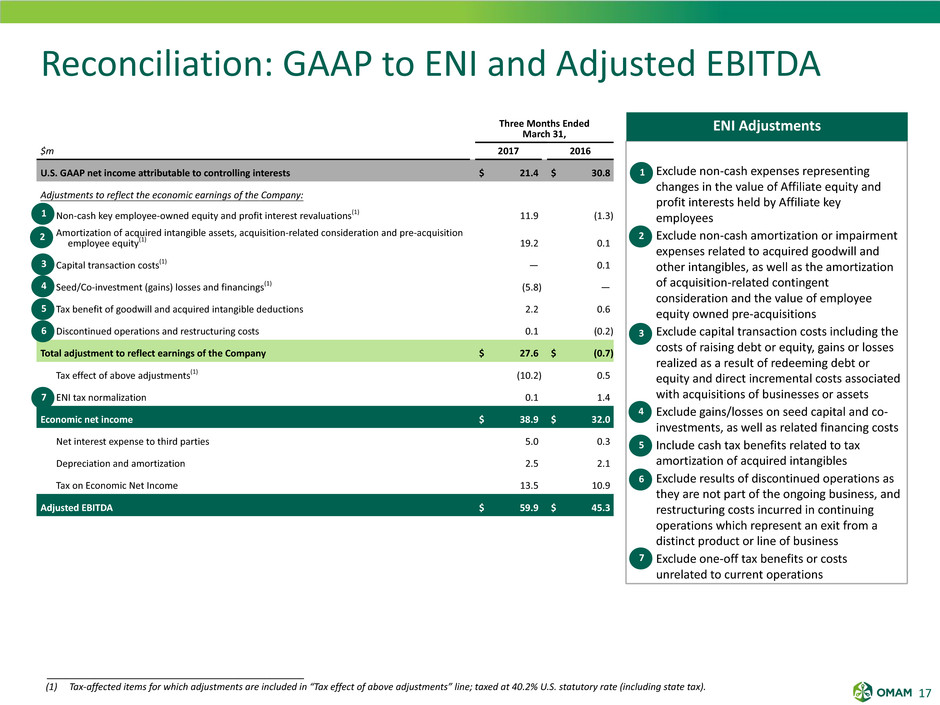
17
i. Exclude non-cash expenses representing
changes in the value of Affiliate equity and
profit interests held by Affiliate key
employees
ii. Exclude non-cash amortization or impairment
expenses related to acquired goodwill and
other intangibles, as well as the amortization
of acquisition-related contingent
consideration and the value of employee
equity owned pre-acquisitions
iii. Exclude capital transaction costs including the
costs of raising debt or equity, gains or losses
realized as a result of redeeming debt or
equity and direct incremental costs associated
with acquisitions of businesses or assets
iv. Exclude gains/losses on seed capital and co-
investments, as well as related financing costs
v. Include cash tax benefits related to tax
amortization of acquired intangibles
vi. Exclude results of discontinued operations as
they are not part of the ongoing business, and
restructuring costs incurred in continuing
operations which represent an exit from a
distinct product or line of business
vii. Exclude one-off tax benefits or costs
unrelated to current operations
Reconciliation: GAAP to ENI and Adjusted EBITDA
ENI AdjustmentsThree Months EndedMarch 31,
$m 2017 2016
U.S. GAAP net income attributable to controlling interests $ 21.4 $ 30.8
Adjustments to reflect the economic earnings of the Company:
Non-cash key employee-owned equity and profit interest revaluations(1) 11.9 (1.3)
Amortization of acquired intangible assets, acquisition-related consideration and pre-acquisition
employee equity(1) 19.2 0.1
Capital transaction costs(1) — 0.1
Seed/Co-investment (gains) losses and financings(1) (5.8) —
Tax benefit of goodwill and acquired intangible deductions 2.2 0.6
Discontinued operations and restructuring costs 0.1 (0.2)
Total adjustment to reflect earnings of the Company $ 27.6 $ (0.7)
Tax effect of above adjustments(1) (10.2) 0.5
ENI tax normalization 0.1 1.4
Economic net income $ 38.9 $ 32.0
Net interest expense to third parties 5.0 0.3
Depreciation and amortization 2.5 2.1
Tax on Economic Net Income 13.5 10.9
Adjusted EBITDA $ 59.9 $ 45.3
___________________________________________________________
(1) Tax-affected items for which adjustments are included in “Tax effect of above adjustments” line; taxed at 40.2% U.S. statutory rate (including state tax).
1
3
2
4
5
1
2
3
4
5
6
7
7
6
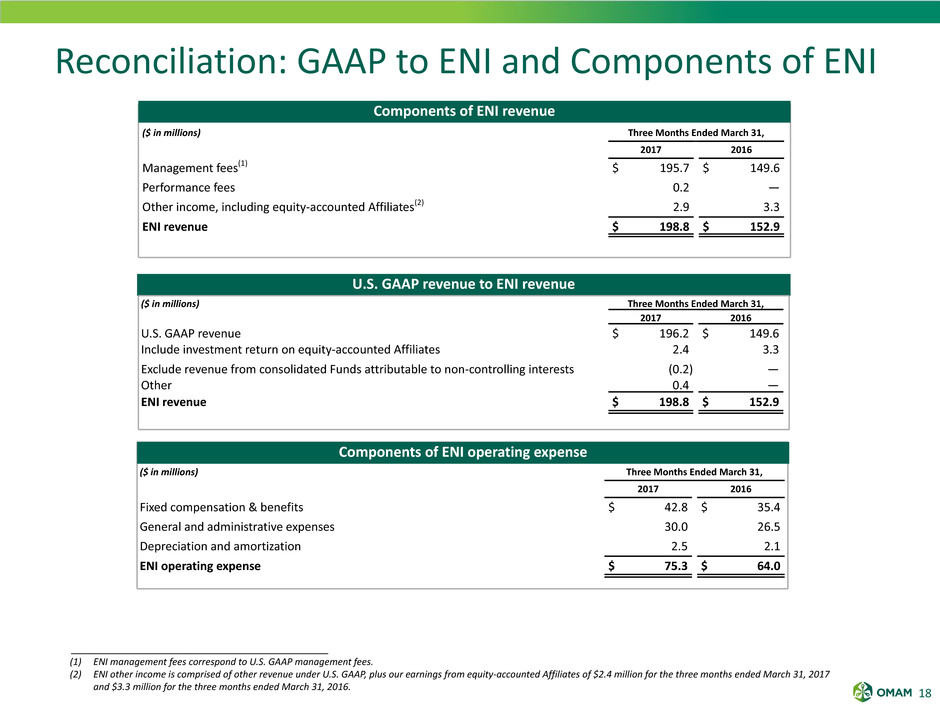
18
U.S. GAAP revenue to ENI revenue
($ in millions) Three Months Ended March 31,
2017 2016
U.S. GAAP revenue $ 196.2 $ 149.6
Include investment return on equity-accounted Affiliates 2.4 3.3
Exclude revenue from consolidated Funds attributable to non-controlling interests (0.2) —
Other 0.4 —
ENI revenue $ 198.8 $ 152.9
Components of ENI operating expense
($ in millions) Three Months Ended March 31,
2017 2016
Fixed compensation & benefits $ 42.8 $ 35.4
General and administrative expenses 30.0 26.5
Depreciation and amortization 2.5 2.1
ENI operating expense $ 75.3 $ 64.0
Reconciliation: GAAP to ENI and Components of ENI
Components of ENI revenue
($ in millions) Three Months Ended March 31,
2017 2016
Management fees(1) $ 195.7 $ 149.6
Performance fees 0.2 —
Other income, including equity-accounted Affiliates(2) 2.9 3.3
ENI revenue $ 198.8 $ 152.9
___________________________________________________________
(1) ENI management fees correspond to U.S. GAAP management fees.
(2) ENI other income is comprised of other revenue under U.S. GAAP, plus our earnings from equity-accounted Affiliates of $2.4 million for the three months ended March 31, 2017
and $3.3 million for the three months ended March 31, 2016.
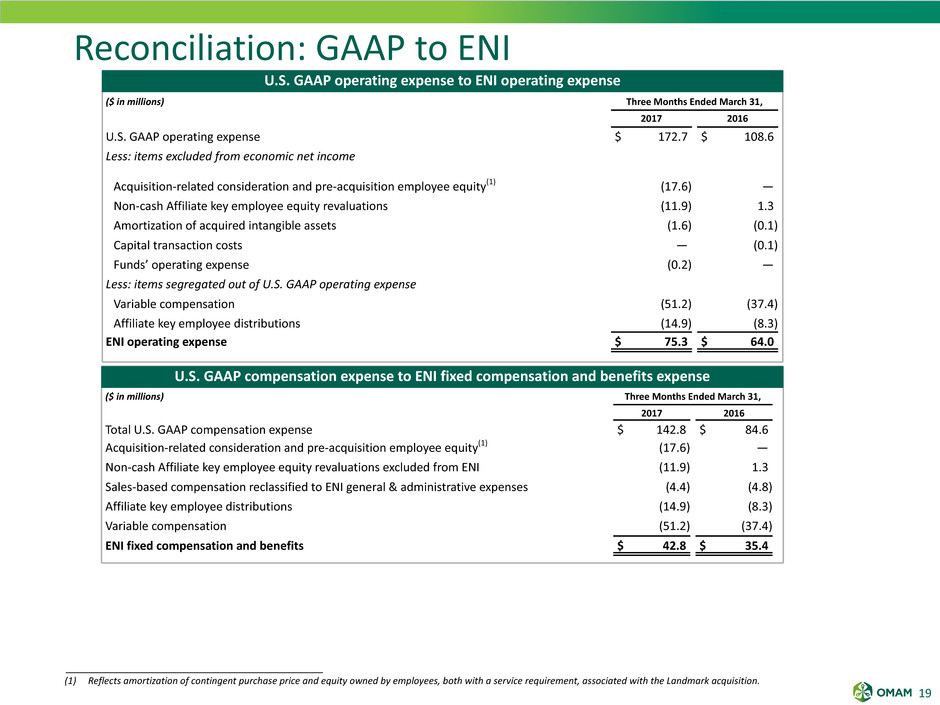
19
U.S. GAAP compensation expense to ENI fixed compensation and benefits expense
U.S. GAAP operating expense to ENI operating expense
($ in millions) Three Months Ended March 31,
2017 2016
U.S. GAAP operating expense $ 172.7 $ 108.6
Less: items excluded from economic net income
Acquisition-related consideration and pre-acquisition employee equity(1) (17.6) —
Non-cash Affiliate key employee equity revaluations (11.9) 1.3
Amortization of acquired intangible assets (1.6) (0.1)
Capital transaction costs — (0.1)
Funds’ operating expense (0.2) —
Less: items segregated out of U.S. GAAP operating expense
Variable compensation (51.2) (37.4)
Affiliate key employee distributions (14.9) (8.3)
ENI operating expense $ 75.3 $ 64.0
($ in millions) Three Months Ended March 31,
2017 2016
Total U.S. GAAP compensation expense $ 142.8 $ 84.6
Acquisition-related consideration and pre-acquisition employee equity(1) (17.6) —
Non-cash Affiliate key employee equity revaluations excluded from ENI (11.9) 1.3
Sales-based compensation reclassified to ENI general & administrative expenses (4.4) (4.8)
Affiliate key employee distributions (14.9) (8.3)
Variable compensation (51.2) (37.4)
ENI fixed compensation and benefits $ 42.8 $ 35.4
Reconciliation: GAAP to ENI
___________________________________________________________
(1) Reflects amortization of contingent purchase price and equity owned by employees, both with a service requirement, associated with the Landmark acquisition.
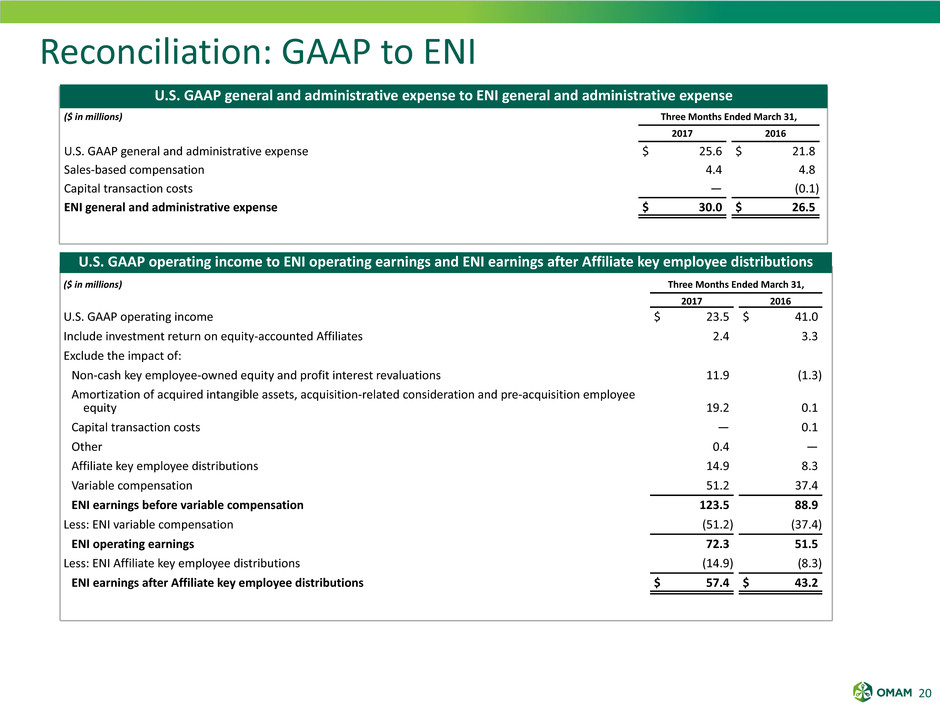
20
($ in millions) Three Months Ended March 31,
2017 2016
U.S. GAAP operating income $ 23.5 $ 41.0
Include investment return on equity-accounted Affiliates 2.4 3.3
Exclude the impact of:
Non-cash key employee-owned equity and profit interest revaluations 11.9 (1.3)
Amortization of acquired intangible assets, acquisition-related consideration and pre-acquisition employee
equity 19.2 0.1
Capital transaction costs — 0.1
Other 0.4 —
Affiliate key employee distributions 14.9 8.3
Variable compensation 51.2 37.4
ENI earnings before variable compensation 123.5 88.9
Less: ENI variable compensation (51.2) (37.4)
ENI operating earnings 72.3 51.5
Less: ENI Affiliate key employee distributions (14.9) (8.3)
ENI earnings after Affiliate key employee distributions $ 57.4 $ 43.2
Reconciliation: GAAP to ENI
U.S. GAAP general and administrative expense to ENI general and administrative expense
($ in millions) Three Months Ended March 31,
2017 2016
U.S. GAAP general and administrative expense $ 25.6 $ 21.8
Sales-based compensation 4.4 4.8
Capital transaction costs — (0.1)
ENI general and administrative expense $ 30.0 $ 26.5
U.S. GAAP operating income to ENI operating earnings and ENI earnings after Affiliate key employee distributions
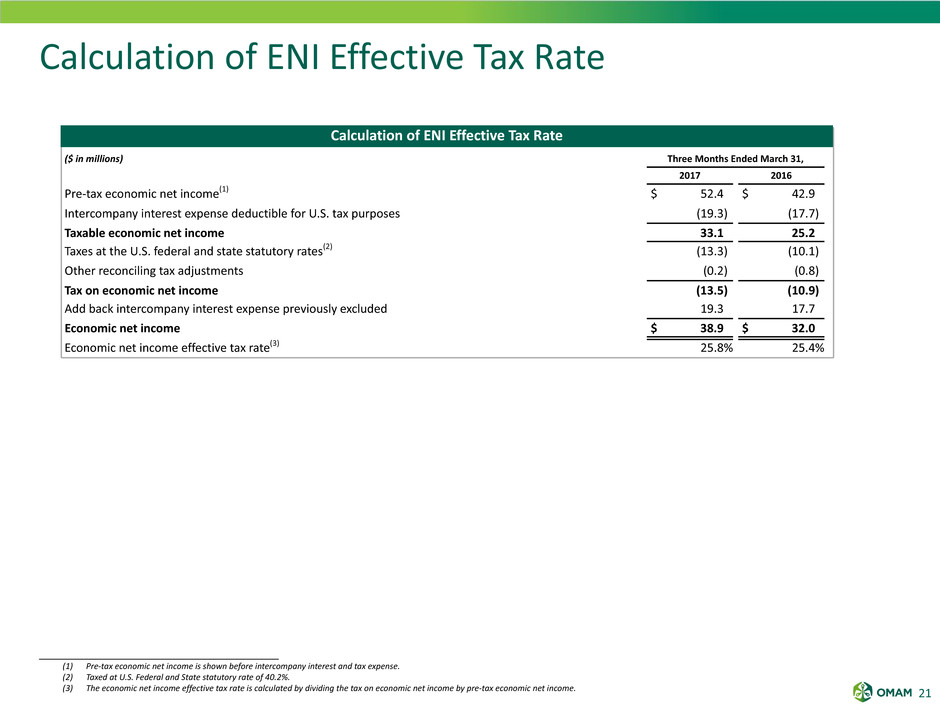
21
Calculation of ENI Effective Tax Rate
($ in millions) Three Months Ended March 31,
2017 2016
Pre-tax economic net income(1) $ 52.4 $ 42.9
Intercompany interest expense deductible for U.S. tax purposes (19.3) (17.7)
Taxable economic net income 33.1 25.2
Taxes at the U.S. federal and state statutory rates(2) (13.3) (10.1)
Other reconciling tax adjustments (0.2) (0.8)
Tax on economic net income (13.5) (10.9)
Add back intercompany interest expense previously excluded 19.3 17.7
Economic net income $ 38.9 $ 32.0
Economic net income effective tax rate(3) 25.8% 25.4%
_______________________________________________________
(1) Pre-tax economic net income is shown before intercompany interest and tax expense.
(2) Taxed at U.S. Federal and State statutory rate of 40.2%.
(3) The economic net income effective tax rate is calculated by dividing the tax on economic net income by pre-tax economic net income.
Calculation of ENI Effective Tax Rate
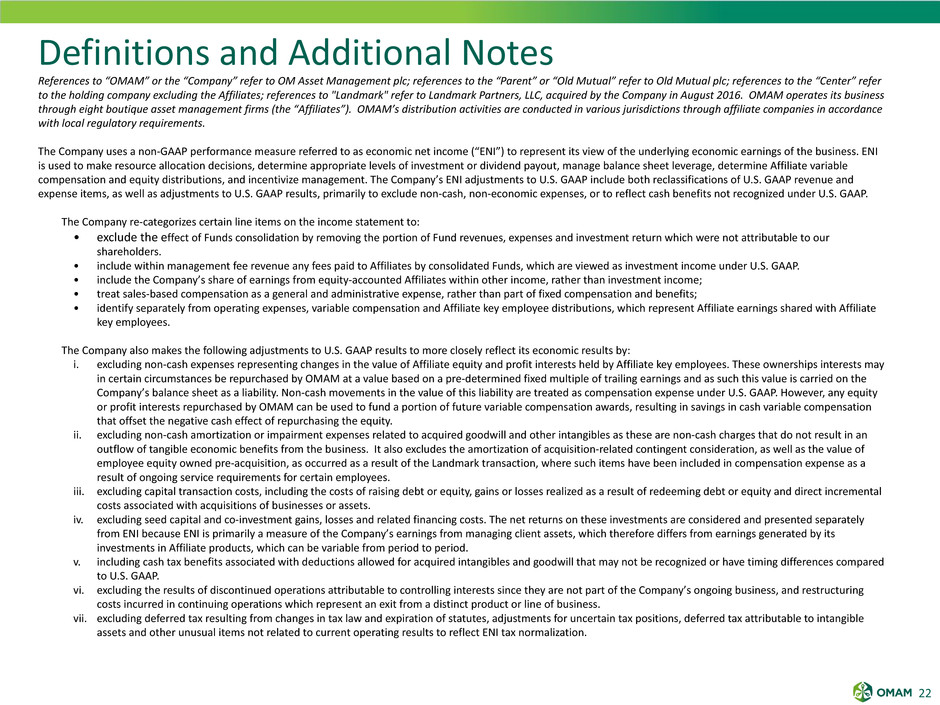
22
Definitions and Additional Notes
References to “OMAM” or the “Company” refer to OM Asset Management plc; references to the “Parent” or “Old Mutual” refer to Old Mutual plc; references to the “Center” refer
to the holding company excluding the Affiliates; references to "Landmark" refer to Landmark Partners, LLC, acquired by the Company in August 2016. OMAM operates its business
through eight boutique asset management firms (the “Affiliates”). OMAM’s distribution activities are conducted in various jurisdictions through affiliate companies in accordance
with local regulatory requirements.
The Company uses a non-GAAP performance measure referred to as economic net income (“ENI”) to represent its view of the underlying economic earnings of the business. ENI
is used to make resource allocation decisions, determine appropriate levels of investment or dividend payout, manage balance sheet leverage, determine Affiliate variable
compensation and equity distributions, and incentivize management. The Company’s ENI adjustments to U.S. GAAP include both reclassifications of U.S. GAAP revenue and
expense items, as well as adjustments to U.S. GAAP results, primarily to exclude non-cash, non-economic expenses, or to reflect cash benefits not recognized under U.S. GAAP.
The Company re-categorizes certain line items on the income statement to:
• exclude the effect of Funds consolidation by removing the portion of Fund revenues, expenses and investment return which were not attributable to our
shareholders.
• include within management fee revenue any fees paid to Affiliates by consolidated Funds, which are viewed as investment income under U.S. GAAP.
• include the Company’s share of earnings from equity-accounted Affiliates within other income, rather than investment income;
• treat sales-based compensation as a general and administrative expense, rather than part of fixed compensation and benefits;
• identify separately from operating expenses, variable compensation and Affiliate key employee distributions, which represent Affiliate earnings shared with Affiliate
key employees.
The Company also makes the following adjustments to U.S. GAAP results to more closely reflect its economic results by:
i. excluding non-cash expenses representing changes in the value of Affiliate equity and profit interests held by Affiliate key employees. These ownerships interests may
in certain circumstances be repurchased by OMAM at a value based on a pre-determined fixed multiple of trailing earnings and as such this value is carried on the
Company’s balance sheet as a liability. Non-cash movements in the value of this liability are treated as compensation expense under U.S. GAAP. However, any equity
or profit interests repurchased by OMAM can be used to fund a portion of future variable compensation awards, resulting in savings in cash variable compensation
that offset the negative cash effect of repurchasing the equity.
ii. excluding non-cash amortization or impairment expenses related to acquired goodwill and other intangibles as these are non-cash charges that do not result in an
outflow of tangible economic benefits from the business. It also excludes the amortization of acquisition-related contingent consideration, as well as the value of
employee equity owned pre-acquisition, as occurred as a result of the Landmark transaction, where such items have been included in compensation expense as a
result of ongoing service requirements for certain employees.
iii. excluding capital transaction costs, including the costs of raising debt or equity, gains or losses realized as a result of redeeming debt or equity and direct incremental
costs associated with acquisitions of businesses or assets.
iv. excluding seed capital and co-investment gains, losses and related financing costs. The net returns on these investments are considered and presented separately
from ENI because ENI is primarily a measure of the Company’s earnings from managing client assets, which therefore differs from earnings generated by its
investments in Affiliate products, which can be variable from period to period.
v. including cash tax benefits associated with deductions allowed for acquired intangibles and goodwill that may not be recognized or have timing differences compared
to U.S. GAAP.
vi. excluding the results of discontinued operations attributable to controlling interests since they are not part of the Company’s ongoing business, and restructuring
costs incurred in continuing operations which represent an exit from a distinct product or line of business.
vii. excluding deferred tax resulting from changes in tax law and expiration of statutes, adjustments for uncertain tax positions, deferred tax attributable to intangible
assets and other unusual items not related to current operating results to reflect ENI tax normalization.
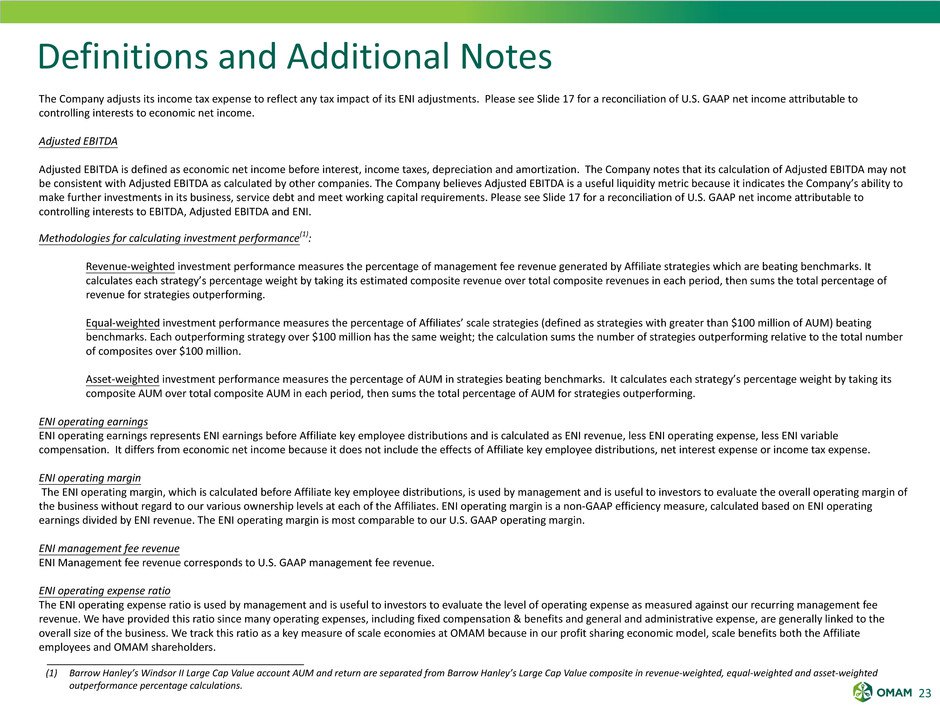
23
The Company adjusts its income tax expense to reflect any tax impact of its ENI adjustments. Please see Slide 17 for a reconciliation of U.S. GAAP net income attributable to
controlling interests to economic net income.
Adjusted EBITDA
Adjusted EBITDA is defined as economic net income before interest, income taxes, depreciation and amortization. The Company notes that its calculation of Adjusted EBITDA may not
be consistent with Adjusted EBITDA as calculated by other companies. The Company believes Adjusted EBITDA is a useful liquidity metric because it indicates the Company’s ability to
make further investments in its business, service debt and meet working capital requirements. Please see Slide 17 for a reconciliation of U.S. GAAP net income attributable to
controlling interests to EBITDA, Adjusted EBITDA and ENI.
Methodologies for calculating investment performance(1):
Revenue-weighted investment performance measures the percentage of management fee revenue generated by Affiliate strategies which are beating benchmarks. It
calculates each strategy’s percentage weight by taking its estimated composite revenue over total composite revenues in each period, then sums the total percentage of
revenue for strategies outperforming.
Equal-weighted investment performance measures the percentage of Affiliates’ scale strategies (defined as strategies with greater than $100 million of AUM) beating
benchmarks. Each outperforming strategy over $100 million has the same weight; the calculation sums the number of strategies outperforming relative to the total number
of composites over $100 million.
Asset-weighted investment performance measures the percentage of AUM in strategies beating benchmarks. It calculates each strategy’s percentage weight by taking its
composite AUM over total composite AUM in each period, then sums the total percentage of AUM for strategies outperforming.
ENI operating earnings
ENI operating earnings represents ENI earnings before Affiliate key employee distributions and is calculated as ENI revenue, less ENI operating expense, less ENI variable
compensation. It differs from economic net income because it does not include the effects of Affiliate key employee distributions, net interest expense or income tax expense.
ENI operating margin
The ENI operating margin, which is calculated before Affiliate key employee distributions, is used by management and is useful to investors to evaluate the overall operating margin of
the business without regard to our various ownership levels at each of the Affiliates. ENI operating margin is a non-GAAP efficiency measure, calculated based on ENI operating
earnings divided by ENI revenue. The ENI operating margin is most comparable to our U.S. GAAP operating margin.
ENI management fee revenue
ENI Management fee revenue corresponds to U.S. GAAP management fee revenue.
ENI operating expense ratio
The ENI operating expense ratio is used by management and is useful to investors to evaluate the level of operating expense as measured against our recurring management fee
revenue. We have provided this ratio since many operating expenses, including fixed compensation & benefits and general and administrative expense, are generally linked to the
overall size of the business. We track this ratio as a key measure of scale economies at OMAM because in our profit sharing economic model, scale benefits both the Affiliate
employees and OMAM shareholders.
Definitions and Additional Notes
___________________________________________________________
(1) Barrow Hanley’s Windsor II Large Cap Value account AUM and return are separated from Barrow Hanley’s Large Cap Value composite in revenue-weighted, equal-weighted and asset-weighted
outperformance percentage calculations.

24
Definitions and Additional Notes
ENI earnings before variable compensation
ENI earnings before variable compensation is calculated as ENI revenue, less ENI operating expense.
ENI variable compensation ratio
The ENI variable compensation ratio is calculated as variable compensation divided by ENI earnings before variable compensation. It is used by management and is useful to
investors to evaluate consolidated variable compensation as measured against our ENI earnings before variable compensation. Variable compensation is usually awarded based on
a contractual percentage of each Affiliate’s ENI earnings before variable compensation and may be paid in the form of cash or non-cash Affiliate equity or profit interests. Center
variable compensation includes cash and OMAM equity. Non-cash variable compensation awards typically vest over several years and are recognized as compensation expense
over that service period. The variable compensation ratio at each Affiliate will typically be between 25% and 35%.
ENI Affiliate key employee distribution ratio
The Affiliate key employee distribution ratio is calculated as Affiliate key employee distributions divided by ENI operating earnings. The ENI Affiliate key employee distribution ratio
is used by management and is useful to investors to evaluate Affiliate key employee distributions as measured against our ENI operating earnings. Affiliate key employee
distributions represent the share of Affiliate profits after variable compensation that is attributable to Affiliate key employee equity and profit interests holders, according to their
ownership interests. At certain Affiliates, OMUS is entitled to an initial preference over profits after variable compensation, structured such that before a preference threshold is
reached, there would be no required key employee distributions, whereas for profits above the threshold the key employee distribution amount would be calculated based on the
key employee ownership percentages, which range from approximately 15% to 40% at our consolidated Affiliates.
U.S. GAAP operating margin
U.S. GAAP operating margin equals operating income from continuing operations divided by total revenue.
Consolidated Funds
Financial information presented in accordance with U.S. GAAP may include the results of consolidated pooled investment vehicles, or Funds, managed by our Affiliates, where it
has been determined that these entities are controlled by the Company. Financial results which are “attributable to controlling interests” exclude the impact of Funds to the extent
it is not attributable to our shareholders.
Annualized revenue impact of net flows (“NCCF”)
Annualized revenue impact of net flows represents the difference between annualized management fees expected to be earned on new accounts and net assets contributed to
existing accounts, less the annualized management fees lost on terminated accounts or net assets withdrawn from existing accounts, including equity-accounted Affiliates.
Annualized revenue is calculated by multiplying the annual gross fee rate for the relevant account by the net assets gained in the account in the event of a positive flow or the net
assets lost in the account in the event of an outflow and is designed to provide investors with a better indication of the potential financial impact of net client cash flows.
Hard asset disposals
Net flows include hard asset disposals made by OMAM’s Affiliates. This category is made up of investment-driven asset dispositions made by Heitman, a real estate manager, or
Campbell, a timber manager.
Derived average weighted NCCF
Derived average weighted NCCF reflects the implied NCCF if annualized revenue impact of net flows represents asset flows at the weighted fee rate for OMAM overall (i.e. 37.7 bps
in Q1'17). For example, NCCF annualized revenue impact of $0.8 million divided by the average weighted fee rate of OMAM’s overall AUM of 37.7 bps equals the derived average
weighted NCCF of $0.2 billion.
n/m
“Not meaningful.”
